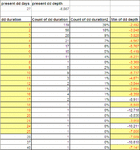Yamato
Legendary member
- Messages
- 9,840
- Likes
- 246
On a seperate subject.
I understand some if not all of the rationale you use to decide which of the total available mechanical systems in the portfolio should be trading live to make up the present combination of systems...but in a sense this choice be it with a methodology/rationale/parametres/rules still involves a human decision, ie yours. To that extent the whole rationale of having a mechanised trading portfolio of systems is underpinned by human intervention/choice as to which systems are actually trading at any given point. Ie it is still a discretionary decision in the same way that I make individual trading decisions based on each set-up that presents itself and it's adherance to certain rules/parametres - but still discretionary decisions involving human intervention/choice - ie my own.
Are there any plans, (and indeed could it be done) to mechanise this system choice/mix of the total available via some kind of algorithm that makes those decisions mechanically and may alter the mix as you currently do discretionarily ?
Interested to hear your thoughts on this and whether you consider this to be a a potential weakness / chink in the armour ?
BBmac.
Replying as I read.
The only problem with discretion is if it requires more work or if it works less well. But in this case, coming up with a formula that entirely automates the systems selection process is:
1) longer than forever picking the systems with a pinch of discretion (and some rules that are fixed but haven't been written - e.g. that the system has been very profitable in back-testing or very profitable in forward-testing or a combination of the two).
2) more profitable than devising and using a formula that (with my present skills) cannot successfully replace my guesstimates
So, until a formula will mean 1) more work and 2) less profitability, then it will be better to not automate the systems selection process. As I said, I am not a Math professor nor any type of academic and I constantly use rule-of-thumb estimates to make money as fast as possible.
And, so, to answer your question, creating a formula right now, with my limited skills, would be a weakness for sure, because it would give me a false feeling of science and precision, and, since the formula would be flawed, it would make things worse.
Let's not forget to say that I have already tried doing what you suggest, several times during the past few years (and subsconsciously I am always thinking about it, without even realizing it), and that is why I am saying what I am saying: I believe I am not ready for that.
But if I had 500 systems instead of 120, and if I were forced to automate because it then becomes more practical to do so, then my formula would be along these lines:
1) enable all systems that have been profitable in forward-testing
2) do a review once every 3 months and change things according to #1.







